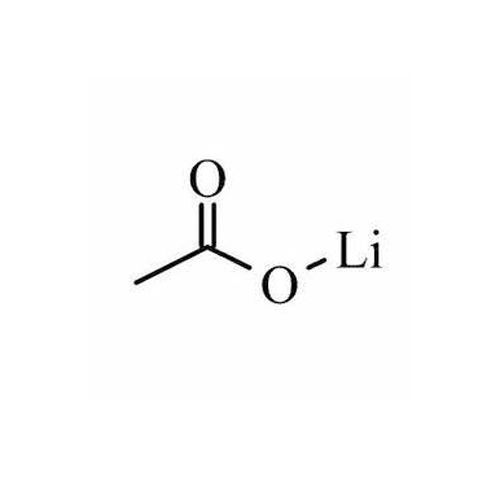Product Description
Lithium Tetraborate is also known as lithium borate. This is the lithium salt of boric acid as well as an ingredient for making ceramics and glasses. It can be utilized in the laboratory as a LB buffer for its use in gel electrophoresis of RNA and DNA. It is also utilized in the borax fusion technique to modify the mineral powder samples for synthesis by WDXRF spectroscopy. It is classified as acidic and is generally utilized for the higher concentrations of basic oxide samples having increased proportions of limestone.
Lithium Tetraborate Properties:
1. CAS No: 12007-60-2
2. Formula: Li2B4O7
3. Molecular Weight: 169.12 g/mol
4. Density: 24 g/cm3
5. Melting Point: 917 degree centigrade
6. Form: Powder
7. Color: White
8. EINECS-No: 234-514-3
Lithium Tetraborate Properties:
1. Chemical Composition: Lithium tetraborate has the chemical formula Li2B4O7, indicating that it contains lithium, boron, and oxygen atoms in a specific ratio.
2. Melting Point: Lithium tetraborate has a relatively high melting point, around 917 degree centigrade, which makes it useful for applications requiring materials that can withstand high temperatures.
3. Solubility: It is sparingly soluble in water, which means it dissolves only to a small extent. This property can be advantageous in certain chemical processes where controlled solubility is desired.
4. Thermal Stability: Lithium tetraborate exhibits good thermal stability, which is essential for its use in various high-temperature applications, such as in the manufacturing of ceramics and glasses.
5. Glass Forming: It is often used in the production of glass because it facilitates the melting process and improves the thermal and chemical resistance of the resulting glass.
6. Fluxing Agent: In metallurgy, lithium tetraborate is used as a fluxing agent, aiding in the removal of impurities during the smelting process.
7. Analytical Chemistry: Lithium tetraborate is utilized in analytical chemistry as a flux for the fusion of samples prior to X-ray fluorescence (XRF) analysis. It helps in forming a homogeneous melt and improving the accuracy of the analysis.
8. Radiation Shielding: Due to its boron content, lithium tetraborate is sometimes used as a neutron shielding material in nuclear reactors and other applications where protection against radiation is required.
9. Lithium Source: It serves as a source of lithium ions in various chemical reactions and processes, contributing to the functionality of lithium-based materials.
10. Biomedical Applications: Lithium compounds, including lithium tetraborate, have been studied for potential biomedical applications, such as in drug delivery systems and biomaterials, due to their unique properties.
Lithium Tetraborate Applications:
1. Glass Manufacturing: Lithium tetraborate is widely used as a flux in glass manufacturing processes. It lowers the melting temperature of silica (SiO2) and other ingredients, facilitating the melting process and improving the thermal and chemical resistance of the resulting glass. This makes it useful in the production of specialty glasses, including those used in optical devices, laboratory glassware, and high-temperature applications.
2. Metallurgy: In metallurgical processes, lithium tetraborate acts as a fluxing agent. It helps reduce the melting point of metal oxides, aiding in the removal of impurities and improving the efficiency of metal refining and alloying processes.
3. Analytical Chemistry: Lithium tetraborate is utilized as a flux in sample preparation for X-ray fluorescence (XRF) analysis. It facilitates the fusion of solid samples, ensuring homogeneity and improving the accuracy and precision of elemental analysis.
4. Nuclear Industry: Due to its boron content, lithium tetraborate is employed as a neutron shielding material in nuclear reactors and other facilities where radiation protection is required. It effectively absorbs neutrons, helping to mitigate radiation hazards.
5. Ceramics: Lithium tetraborate is used in the manufacturing of ceramics, particularly in glazes and enamels. It aids in controlling the viscosity of ceramic slurries and enhances the properties of the final product, such as hardness, thermal stability, and resistance to chemical corrosion.
6. Thermoluminescence Dosimetry (TLD): Lithium tetraborate crystals are utilized as dosimeters in radiation dosimetry applications. When exposed to ionizing radiation, these crystals trap energy, which can be subsequently released as visible light upon heating. This property makes them valuable for measuring radiation doses in medical and industrial settings.
7. Electronics: In electronics, lithium tetraborate is used in the production of lithium borate glasses and ceramics, which have applications in capacitors, insulators, and other electronic components due to their dielectric properties and thermal stability.
8. Biomedical Research: Lithium compounds, including lithium tetraborate, are studied for potential biomedical applications. Research is ongoing to explore their use in drug delivery systems, biomaterials, and medical imaging due to their biocompatibility and unique chemical properties.
Lithium Tetraborate FAQ:
Q. How is lithium tetraborate used in glass manufacturing?
Ans: Lithium tetraborate acts as a flux in glass manufacturing, reducing the melting temperature of silica and other ingredients, thereby facilitating the melting process and enhancing the thermal and chemical resistance of the resulting glass.
Q. What role does lithium tetraborate play in analytical chemistry?
Ans: In analytical chemistry, lithium tetraborate is utilized as a flux in sample preparation for X-ray fluorescence (XRF) analysis. It aids in fusing solid samples, ensuring homogeneity, and improving the accuracy of elemental analysis.
Q. What are the benefits of using lithium tetraborate in ceramics?
Ans: Lithium tetraborate improves the viscosity control of ceramic slurries, enhances the properties of ceramics such as hardness and thermal stability, and provides resistance to chemical corrosion, making it valuable in ceramic manufacturing.
Q. How does lithium tetraborate serve in radiation dosimetry?
Ans: Lithium tetraborate crystals are used as dosimeters in thermoluminescence dosimetry (TLD). When exposed to ionizing radiation, these crystals trap energy and release it as visible light upon heating, allowing for the measurement of radiation doses in various applications.
Q. Is lithium tetraborate safe for biomedical research?
Ans: Lithium compounds, including lithium tetraborate, are studied for potential biomedical applications due to their biocompatibility and unique chemical properties. Research is ongoing to explore their use in drug delivery systems, biomaterials, and medical imaging.



